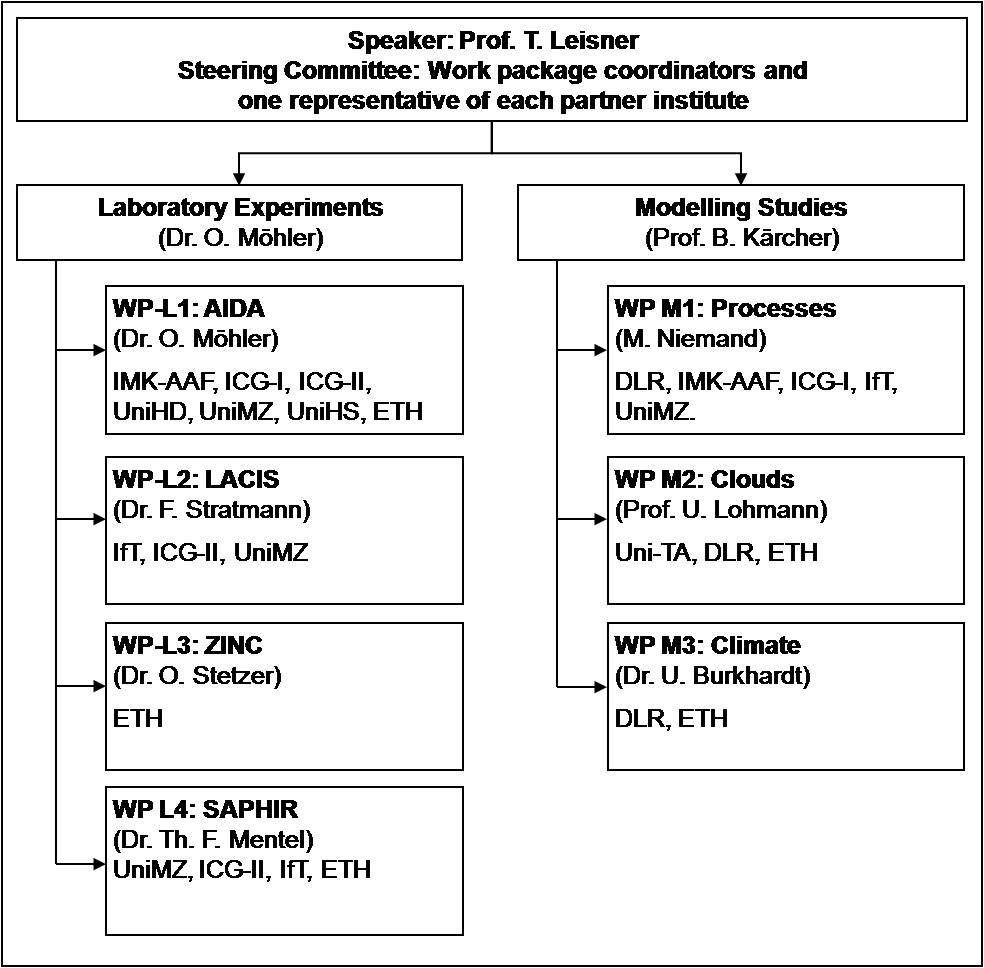VI-ACI
- contact:
Dr. Ottmar Möhler
- project group:
Prof. Thomas Leisner
Dr. Ottmar Möhler - funding:
Helmholtz Association
- startdate:
01.04.2007
- enddate:
31.03.2011
VI-ACI: Helmholtz Virtual Institute on Aerosol-Cloud Interactions
Project Description

Background
Clouds are important regulators of the Earth's global temperature, because they scatter shortwave visible radiation from the sun back to space (cooling effect) and absorb long wave infrared radiation emitted from the Earth surface (warming effect).
Clouds are formed by the condensation of water vapour on aerosol particles of natural and anthropogenic origin. These aerosol particles are called cloud condensation nuclei (CCN). If cloud droplets are cooled below 0°C, most of them remain in a supercooled liquid state. Pure water droplets freeze only at temperatures below about -36°C. At warmer temperatures, the freezing of cloud droplets is induced by a minor fraction of the atmospheric aerosol particle mixture. These particles are called heterogeneous ice nuclei (IN).
The formation of the ice phase in clouds is of central importance because it has a strong influence on their life cycles and radiative properties, and, in many cases, initiates precipitation. The response of cloud characteristics and precipitation processes to changing natural and anthropogenic aerosol sources is one of the largest uncertainties in the current understanding of climate change.
A major challenge is therefore to determine the ability of aerosols to act as CCN and IN and to develop aerosol-related parameterisations for the representation of CCN and IN processes in cloud, weather forecast, and climate models. The Virtual Institute VI-ACI aims at detailed experimental and modelling investigations of aerosol cloud processes and novel evaluations of the role of clouds in the climate system.
Objectives
In the Helmholtz Virtual Institute on the “Role of aerosol particles as condensation and ice nuclei in tropospheric clouds (VI-ACI)”, three Helmholtz Centres, one Leibniz Institute, and 6 Universities combine their expertise and efforts in the field of aerosol-cloud interactions to closely cooperate on the follow-ing scientific objectives:
- Quantify the efficiency of aerosols from natural (desert dust, secondary organic aerosol, bio-genic particles) and anthropogenic (air traffic emissions, ground-based combustion particles) sources to act as cloud condensation nuclei (CCN) and ice nuclei (IN) in mixed-phase and cirrus clouds.
- Quantify the variation of CCN and IN efficiency by particle transformation, e.g. condensed-phase processes, surface modification by heterogeneous chemistry, or coating by condensation of less volatile compounds.
- Study the formation and slow transformation of potential CCN and IN from representative pre-cursor mixtures, natural light, and oxidant levels.
- Perform experiments at simulated cloud conditions to investigate the competition of different aerosol types for cloud droplet formation and heterogeneous freezing.
- Improve existing or develop novel concepts for aerosol-related parameterisations of ice nuclea-tion in cloud and climate models.
- Investigate the sensitivity of precipitation initiation in cloud models to the natural variability of CCN and IN concentrations and their properties measured in the laboratory experiments.
- Investigate the partitioning of water in life cycles of cirrus clouds by cloud chamber simula-tions, link
he observations to field measurements, and reproduce the measurements with model simulations. - Determine particle composition and mixing state of ubiquitous UTLS aerosol composition (sulphate, organics, soot) by means of process-oriented modelling in support of laboratory measurements of ice nucleation activity of such mixtures.
- Study of cirrus clouds and the contrail-to-cirrus transition with newly developed state-of-the-art cloud-resolving simulation models.
- Interpret field measurements with cloud resolving models using new parameterisation schemes.
- Quantify the global impact of IN on cirrus microphysical properties with realistic IN properties guided by the laboratory experiments.
- Quantify, with general circulation models, the global impact of cirrus and the contribution of contrail-cirrus to high cloud occurrence along with their associated radiative forcing of climate.
- Investigate the sensitivity of the radiation budget and the hydrological cycle in climate model simulations to the new parameterisations of CCN and IN efficiency of relevant tropospheric aerosol particles developed within this project.
Project Partners
| Thomas Leisner, Ottmar Möhler (Project coordinator) |
Karlsruhe Institute of Technology, Institute for Meteorology and Climate Research | |
 |
Ulrich Schumann, Bernd Kärcher | Deutsches Zentrum für Luft- und Raumfahrt, Institut für Physik der Atmosphäre |
 |
Martin Riese, Martina Krämer |
Forschungszentrum Jülich, ICG-1 Forschungszentrum Jülich, ICG-2 |
 |
Frank Stratmann | Leibniz Institute for Tropospheric Research (IfT) |
 |
Stephan Borrmann, Johannes Schneider | Universität Mainz, Institut für Physik der Atmosphäre |
| Joachim Curtius, Ulrich Bundke | Universität Frankfurt, Institut für Atmosphäre und Umwelt | |
 |
Volker Ebert | Universität Heidelberg, Physikalisch-Chemisches Institut |
| |
Ulrike Lohmann, Olaf Stetzer | ETH Zurich, Institute for Atmospheric and Climate Science |
| Paul Kaye, Zbigniev J. Ulanowski | University of Hertfordshire, Science and Technology RI | |
 |
Zev Levin | Tel Aviv University, Cloud and Precipitation Physics Laboratory |
Project Structure

